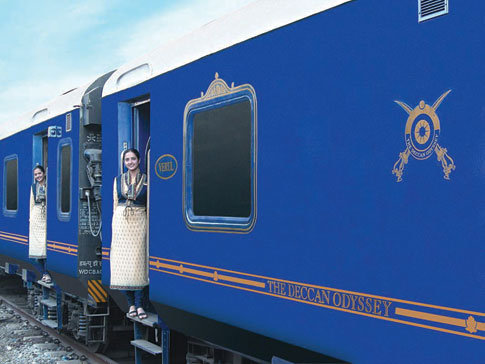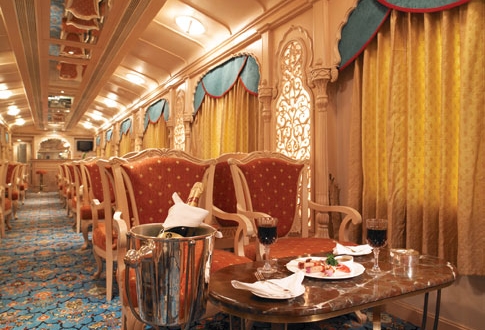
If you sign up for this one, it’s an experience that will stay with you forever. Launched about seven years ago, Deccan Odyssey, a luxury train, takes you on a heritage tour through the majestic Kingdom of the Marathas. Built on the lines of the Blue Train of South Africa, The Orient Express of Europe and the Eastern and Oriental of South East Asia, the royal train offers you a weeklong sojourn.
A royal journey is through some of the best places in Maharashtra like Mumbai, Sindhudurg, Tarkarli, Goa, Kolhapur, Aurangabad, Ellora, Ajanta and Nasik. The objective of running “The Deccan Odyssey” train is primarily to showcase the best of tourism assets of Maharashtra like pristine beauty of Konkan coast, the art, the culture, the heritage (including world heritage sites of Ajanta -Ellora) of Maharashtra as well as Maharashtra’s local arts, crafts and cuisine.
The Maharashtra Tourism Development Corporation (MTDC) Ltd is running the train in association with Indian Railways and Ministry of Tourism. A sheer delight, everything in the train reflects the ways of Indian Royalty. The plush interiors, delicious cuisine and great sites to see make the journey memorable. This luxurious train transports its guests on a remarkable sojourn of a land shining in legends’ grandeur, serene beaches, magnificent forts and palaces and experiencing divine tales etched in colossal rocks.

Tourists from the United Kingdom, Singapore, Germany, France and Australia make a beeline for the odyssey. The MTDC is also trying to promote the luxury product to Indians. About four to five trips are planned during the year.
Day 1 – Mumbai
Day 2: Sindhudurg Nagri-Sindhudurg Fort-Tarkarl Beach-Dhamapur village
Day 3: (Goa) Visit to St. Augustine Church, Basilica of Bom Jesus Church, Se Cathedral Church, St Francis of Assissi, a Museum of Goan antiques and visit to Fontanhas the Latin Quarters at Panjim.
Day 4: (Vasco, Goa) Visit to Mangeshi, a Hindu Temple; the Safa Masjid a prominent Islamic Shrine, Sahakari Spice Farm, Menezes Braganza House at Chandor village.
Day 5: Kolhapur- New Palace, Museum, Bhavani Mandap Mahalaxmi Temple, Shalini Palace.
Day 6: Aurangabad, Daulatabad, Ellora Caves, Bibi-ka-Maqbara
Day 7: Ajanta Caves /Nashik
Day 1
Board the train in the evening at the Chhatrapati Shivaji Terminus, a world heritage site. This is undoubtedly one of the famous Gothic buildings, and an integral part of Mumbai’s skyline
Day 2
Next day the train chugs in to the tip of the Konkan coast, Kudal railway station. A luxury AC bus transfers you to Malvan Jetty from the station. From here a boat rides to unconquered Ocean Fort of Sindhudurg. Walk on two-mile long rampart walls and watch breathtaking view of the vast open sea as it fires a volley of spray 30 ft below.
From here head out to Tarkarli, a virgin beach at the confluence of river Karli and Arabian Sea. A hard day at the sea is imminent, so rest at the Tarkarli Beach Resort’s ‘Konkani’ style cottages is soothing. It’s a perfect place to enjoy the mouth-watering ‘Malvani’ cuisine and then unwind. In the afternoon depart for Kudal railway station, and on the way visit Dhamapur, a village situated on the banks of the lake. Dinner is served on board.
Day 3

Goa is an exotic destination frequented by tourists from all corners of the globe. Ancient churches and elegant mansions, splashed with colour of bougainvillea. You can start the trip with Old Goa. Take a walk amid the ruins of St Augustine Church, once largest cathedral in Goa. Basilica of Bom Jesus, a 16th Century Church, where the mortal remains of St. Francis Xavier is enshrined. Se Cathedral and the Church of St Francis of Assissi that began as a mosque, but now is an archaeological museum for Goan antiques. Take a walk through Fontanhas, the Latin quarters at Panjim, and a short walk though Panjim, the capital of Goa. One can do some shopping to carry memories of this beautiful state. It’s time for afternoon finger-licking Goan delicacies onboard. In the evening, proceed to beach-front hotel for cultural program me and dinner.
The architecture and the interiors of the house make you feel as if you are going back in history. It is one of the oldest heritage houses of Goa. This has been the traditional family home of the Braganzas for many than four centuries.
Day 4

In the morning alight at Vasco station and board the bus to visit Mangeshi, a Hindu temple of Lord Shiva revealing typical architecture of old temples and the Safa Masjid. It is a prominent Islamic shrine in Ponda, commonly regarded the citadel of Hindu pilgrimages in Goa, and was built in 1560 by Ibrahim Adil Shah, the Sultan of Bijapur. From here proceed to one of the biggest and finest spice farms in the Country a “Sahakari Spice Farm” at Ponda village. Situated among the lush green surroundings of Ponda, it is very popular among international tourists. Visitors are traditionally welcomed at the entrance. After brief halt in the restaurant for welcome drink and snacks, a guided tour of the farm starts. This organic spice farm has variety of herbal and medicinal trees. A typical Goan lunch is served here. Next stop: One of the finest heritage houses of 16th century known as “Menezes Braganza House”. It is one of the last remaining structures that date back to the pre-Portuguese era in Goa.
The architecture and the interiors of the house make you feel as if you are going back in history. It is one of the oldest heritage houses of Goa. This has been the traditional family home of the Braganzas for many than four centuries. The lady of the house, Mrs Braganza, an octogenarian, still lives in the house and takes the visitors to a tour of the house herself. Then proceed to Madgaon railway station to board the train for Kolhapur. Enjoy the dinner onboard.
Day 5

You are in Kolhapur, a city with mythical past. The Hindu era lasted till 1347, followed by the Muslim rule which was from 1347-1700. The magnificent temples of Kolhapur were built during the glorious periods of the Satavahana kings and the Shilaharas. The Marathas controlled this area from 1700 to 1849. In 1849, the British took over and Chhatrapati Sahu Maharaj was declared as the ruler of Kolhapur. First stop is at New Palace, this architectural marvel known as the Chhatrapati Shahu Museum. The museum houses rare paintings and artifacts used by the royal family. Royal weapons and a tableau depicting court life of the last century create an aristocratic ambience.

Next is Bhawani Mandap (The Town Hall). Antiques found during the excavations at Brahmagiri, old sculptures, filigree work in sandal wood and ivory, old coins and paintings of master artists of the region are all displayed here. Move on to see an exquisitely carved Mahalaxmi Temple,here you learn how the demon Kolhasura was destroyed by Goddess Mahalaxmi and then proceed to Shalini Palace to enjoy traditional Martial Art locally known as “Mardani Khel” and cultural programme. Collect some great mementos from an array of handicraft stalls. At noon board the train at Kolhapur station. Enjoy the lunch and leisure time onboard as the train moves on for next destination. Dinner is also onboard.
Day 6
Travelling along the rolling hills and picturesque ruins of the past, you travel way back in time to Aurangabad. Founded by Aurangzeb, Aurangabad’s heritage is rich and diversified.
After breakfast in the train, a luxury coach takes you to the majestic fortress of Daulatabad. Visit world famous Ellora Caves. This World Heritage Site’s 34 brilliantly carved rock-cut temples represent Buddhist, Jain and Hindu faiths. The caves include ‘viharas’ (monasteries) and ‘chaityas’ (chapels) where the monks worshipped. The Hindu caves lie in the centre of the group. The most famous of them being the Kailasanatha Temple (8th century). It is the most magnificent of all the rock-cut structures at Ellora. Completely open to the elements, it is the only building that was begun from the top. The Jain caves, less grand in comparison to the others, are richly carved with lotus, elephant, lions and ‘tirthankaras’ of Lord Mahavira. They offer an aura of peace and simplicity. Come back to Aurangabad for lunch at the 5 star hotel. Post-lunch, visit Bibi-ka-Maqbara, a replica of Taj Maha and symptomatic of the grand Mughul architecture. Enjoy shopping for Paithani, Himroo, Bidriwork from showrooms for a perfect memorabilia.
Day 7
Seventh day brings you to Jalgaon railway station. After a royal breakfast, depart for T-Junction in a luxury AC bus. Board the eco-friendly bus to surround yourself by dramatic views of the Waghora Valley, the hideout of the Ajanta Caves. Older than the Ellora caves, these caves once lost to the world, were discovered by accident in 1819, by a party of British officers on a hunting expedition.
At Ajanta, ‘Bodhisattva Padmapani’, ‘Boddhisattva Avalokitesvara’. ‘The Birth of the Buddha’ and ‘The Thousand Buddhas’ is among the finest murals and sculptures ever found. The paintings on the ceiling, particularly the elephant scattering the lotus, charging bull, the black princess and the row of dancers with musicians mesmerize tourists from all over the world.
After a quick shopping break for artifacts and souvenirs, head back to o Jalgaon railway station. Mouthwatering lunch awaits onboard as you reach Nashik, from where travel by AC bus to Panchavati Ghat, a holy land of Kumbh Mela, a pilgrim fair held once in every 12 years. Visit Kala Ram Temple built in 1794 and feel blessed.
Finally, when you head back to the Nashik, it’s time for the Deccan Odyssey to get you back to Mumbai, the business capital of India. Enjoy the breakfast on board as the sun rises over the commercial capital of India. Alight at the Chhatrapati Shivaji Terminus in themorning enriched with the rich legacy of this land.






